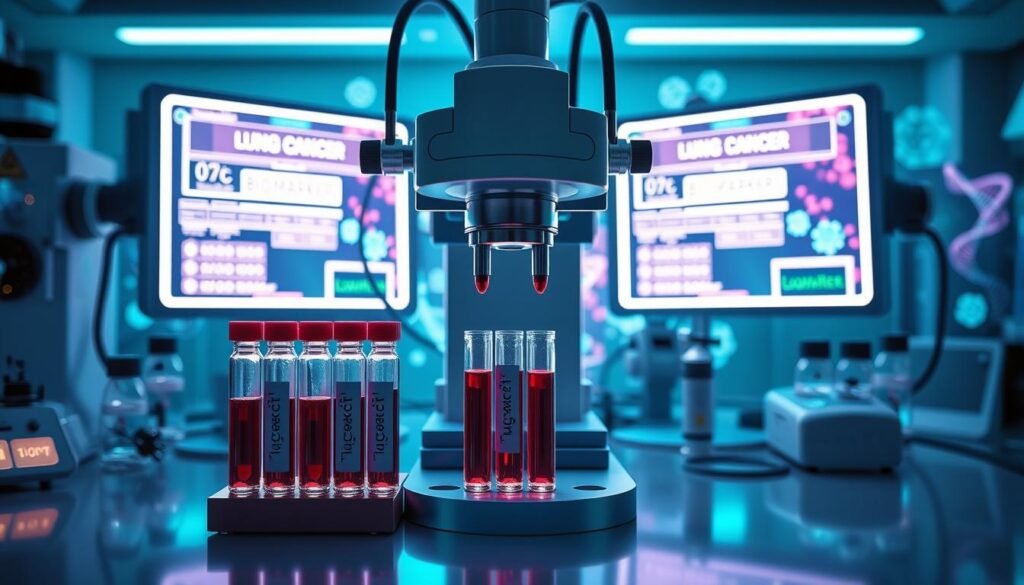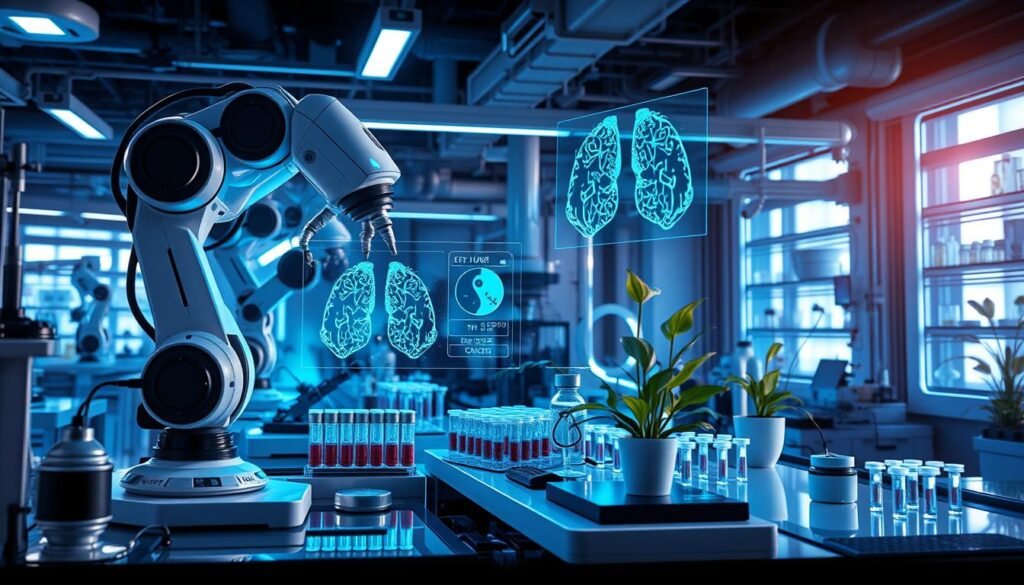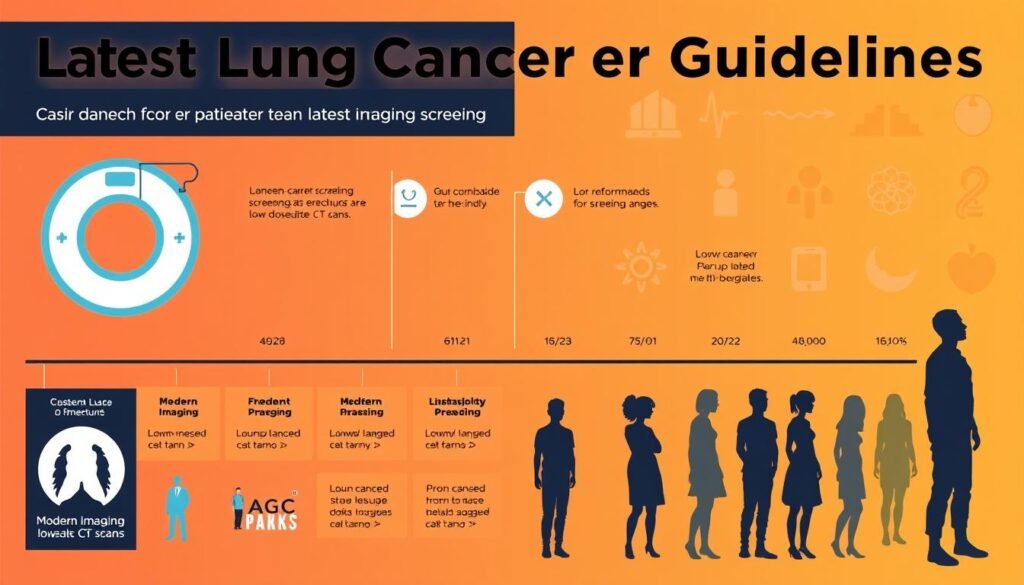Did you know lung cancer causes nearly 20% of all cancer deaths in the U.S. each year? Traditional screening methods, like low-dose CT scans, have drawbacks, such as false positives and high costs. However, the rise of lung cancer blood markers is changing the game. Recent breakthroughs in testing, like liquid biopsies, are making lung cancer detection faster and more accurate.
Understanding biomarker testing is key in lung cancer research. Researchers are learning more about the proteins and genetic mutations involved. These discoveries are crucial for creating personalized treatments that improve survival rates. This article will look into the newest findings on lung cancer blood markers and their role in fighting this deadly disease.
Key Takeaways
- Lung cancer detection is critically improved through emerging blood markers.
- Liquid biopsy technology is paving the way for rapid and non-invasive testing.
- Biomarker testing is essential for tailoring effective treatment plans in lung cancer.
- New blood tests can detect lung cancer with high sensitivity and quick turnaround times.
- Awareness of specific lung cancer biomarkers can significantly guide treatment decisions.
Understanding Lung Cancer and Its Impact
Lung cancer is a major health issue, especially for people who smoke. Lung cancer statistics show most cases are in smokers. Yet, about 10% to 20% of cases occur in those who’ve never smoked. This fact shows everyone needs to know about lung health awareness. It’s key in warning people about the risks, smokers and nonsmokers alike.
Early detection of lung cancer is tough since it often grows silently. Signs like a lasting cough, losing weight without trying, and hard breathing are typical lung cancer symptoms. Knowing these signs can lead people to get help early on. Education on lung cancer symptoms is crucial. It can help catch the disease early, improving the chances of recovery.
Lung cancer mainly starts in the cells lining the bronchial tubes. It has different stages, from early, non-invasive forms to aggressive types that spread. Unfortunately, most lung cancers are found because of symptoms, not regular check-ups. This means awareness is key to catching it sooner.
Finding educational resources about lung cancer helps people learn how to prevent it and understand treatment choices.
More awareness leads to a greater need for health actions focused on lowering risks. It’s also about helping those with lung cancer. By stressing early detection and recognizing symptoms, we can fight smoking and lung cancer more effectively.
The Importance of Early Detection in Lung Cancer
Finding lung cancer early is very important. Studies show that acting fast can greatly increase survival rates. One effective way is through low-dose CT (LDCT) scans. These scans reduce death rates by 20-25% compared to regular chest x-rays.
Yet, many who could benefit don’t know about LDCT scans. They might struggle with the cost or finding a place to get scanned. Regular screening is so important for lung cancer treatment. People between 50 and 80 years old with a history of heavy smoking should get scanned, as recommended by the American Cancer Society.
Getting an LDCT scan is easy and quick. But, some are worried about the small amount of radiation it uses. Luckily, most health insurance, including Medicare, often covers the cost of these screenings.
Some people find it hard to get screened because they live far from a clinic. We need more awareness and education to get more people screened in areas where lung cancer is more common. For more info on how biomarkers help find lung cancer, check out this resource.
Screening early can lead to finding cancer sooner. This can make treatments work better and improve chances of survival. By promoting regular screenings, we can change the future of lung cancer for many people.
What Are Lung Cancer Blood Markers?
Lung cancer blood markers are key substances in our blood. They provide information about lung cancer’s presence and growth. These markers help in catching cancer early. This allows doctors to create personalized treatments. Liquid biopsies are a new way to look at these markers. They are less intrusive than older methods, helping to find cancer sooner.
Definition and Role of Blood Markers
Blood markers are indicators for conditions like lung cancer. They include proteins, mutations, and tumor DNA. These can show if the disease is starting. Such markers are vital for biomarker testing. This testing helps healthcare providers decide on the best treatment. Knowing about these markers can bring more personal care. It can also increase survival chances for lung cancer patients.
Common Types of Lung Cancer Blood Markers
There are several key blood markers for lung cancer. Below are the common ones:
| Biomarker | Type of Lung Cancer | Function |
|---|---|---|
| NSE | Small Cell Lung Carcinoma (SCLC) | Prognosis and monitoring |
| ProGRP | Small Cell Lung Carcinoma (SCLC) | Diagnosis and response evaluation |
| SCCA | Non-Small Cell Lung Carcinoma (NSCLC) | Detection and prognosis |
| CYFRA 21-1 | Non-Small Cell Lung Carcinoma (NSCLC) | Monitoring and therapy response |
| CEA | Non-Small Cell Lung Carcinoma (NSCLC) | Detection of recurrence |
Using different markers together improves diagnosis and tracking. This approach works well for SCLC and NSCLC types. Early detection using liquid biopsy can really change treatment success. Including protease enzymes with these markers gives deeper insights. It helps in understanding tumor growth better, making testing crucial in managing lung cancer. For deeper insights, check out this resource.
Lung Cancer Blood Markers: Latest Tests and Research
Recent advances in liquid biopsy tech are key in improving lung cancer diagnosis. They allow us to spot the activity of protease enzymes. These enzymes are important indicators of lung cancer. This new method is about 90% accurate. It makes cancer blood tests more effective. It’s really good at finding lung cancer early. Especially when you compare it with traditional methods like chest CT scans.
New Developments in Liquid Biopsy Technology
Liquid biopsy technology is changing how we test for lung cancer. It uses blood samples instead of scans to find cancer markers. Researchers are studying markers like CIZ1B at the Moffitt Cancer Center. This could greatly improve how we find and understand lung cancer early on. It might even help us see if the cancer could come back after treatment.
Research on Protease Enzyme Detection
Researchers are focusing on finding protease enzymes to screen for lung cancer. This could lead to affordable tests that many people can use. These tests could be done even at your local doctor’s office. This makes screening more available to everyone. Studies on circulating tumor cells (CTCs) and tumor-macrophage fusion (TMF) cells are ongoing. Some results look promising especially for patients with non-small-cell lung cancer (NSCLC). A study found CTCs in all NSCLC patients tested. But, TMF cells were less common in the same group. This hints at the challenge of making dependable blood tests for cancer. For more details on lung cancer markers, check out this source.

| Biomarker | Presence in NSCLC Patients | Presence in Control Group |
|---|---|---|
| Circulating Tumor Cells (CTCs) | Present in 100% of NSCLC patients | Absent |
| Tumor-Macrophage Fusion (TMF) Cells | Detected in 48% of NSCLC patients | Not found in benign nodules |
| CIZ1B | Under clinical evaluation | Not applicable |
Biomarker Testing and Its Significance
Biomarker testing is key in finding the right lung cancer treatments. It checks for DNA changes and protein levels. This helps doctors pick treatments suited to each patient. It makes the therapy more effective and reduces side effects.
Understanding Biomarkers in Lung Cancer Treatment
Biomarker testing is especially important in non-small cell lung cancer (NSCLC). It looks for specific mutations like ALK and EGFR. These mutations show if targeted therapies will work. Immunotherapy, based on test results, helps the immune system fight cancer. Clinical trials also use biomarkers to choose the best treatments. This ensures patients get the most suitable therapy when they need it.
The Benefits of Targeted Therapies
Targeted therapies are a big step forward in lung cancer treatment. They focus on genetic changes in tumor cells. Biomarker tests find these mutations or protein changes, affecting how well treatments work. EGFR inhibitors, for example, work best on cancers with certain mutations. This approach aims for success while sparing healthy cells.
Not everyone may be right for targeted therapies, but other treatments like chemotherapy are available. Support programs help patients get the biomarker testing they need. This shows a strong commitment to personalized care in lung cancer treatment.
Artificial Intelligence in Lung Cancer Detection
Artificial intelligence plays a key role in finding lung cancer early. By using advanced methods like DNA analysis, AI improves the chances of detecting cancer sooner. This could lead to better treatment options. Computer modeling is also a powerful way to make sense of complex data from different sources.
How AI Enhances Early Detection
Using artificial intelligence in detecting lung cancer offers big benefits. AI systems can correctly identify lung cancer with high accuracy. They have a sensitivity rate of 0.87. The specificity rate is also 0.87. This means AI is good at finding lung cancer early on.
These technologies go through huge amounts of data quickly. They spot patterns and unusual signs that might be missed otherwise. This is how AI helps in diagnosing lung cancer better and faster than before.
Recent Studies and Breakthroughs
Recent studies show how much AI can change the game in lung cancer detection. The chance of correctly identifying cancer with AI is high, with a positive likelihood ratio of 6.5. AI is reliable. It has low missed and wrong diagnosis rates, both at 13%.
The area under the curve (SROC) for AI in lung cancer diagnosis has reached 0.93. This means AI is great at predicting lung cancer.

| Metric | Value | Confidence Interval |
|---|---|---|
| Sensitivity | 0.87 | 0.82 – 0.90 |
| Specificity | 0.87 | 0.82 – 0.91 |
| Missed Diagnosis Rate | 13% | N/A |
| Misdiagnosis Rate | 13% | N/A |
| Positive Likelihood Ratio | 6.5 | 4.6 – 9.3 |
| Negative Likelihood Ratio | 0.15 | 0.11 – 0.21 |
| Diagnostic Ratio | 43 | 24 – 76 |
| SROC Area | 0.93 | 0.91 – 0.95 |
This new approach highlights how AI could change lung cancer detection. It may increase survival rates by finding the disease early. With ongoing improvements in AI, the future of diagnosing lung cancer looks bright.
Challenges in Lung Cancer Screening and Diagnosis
Lung cancer is the main cause of death from cancer around the world. There are big challenges in lung cancer screening that affect finding it early. Only 6-10% of people at high risk get screened each year. This low number shows the big lung cancer screening barriers many face.
One big hurdle is the cost of screening tests like low-dose computed tomography (LDCT). The high cost stops people from getting screened. This is especially true for those without insurance. A shocking 72% of people without insurance don’t get the screenings they need. In rural areas, getting to a screening center is hard for about 14.9% of people. They don’t have one close enough.
Knowing about lung cancer risk factors and early detection is also key. Many people don’t know their risk, especially if they’ve never smoked. In the U.S., 12.5% of lung cancer patients have never smoked. This shows we need to do better in teaching people. We must increase awareness to get more people screened.
Fear of finding out they might have cancer stops some from getting screened. This worry about a possible bad diagnosis makes them avoid testing. Overcoming these lung cancer screening barriers is crucial. We must make screening more accessible, affordable, and make sure people know how important it is. This approach will help lower the deaths from this disease.
Current Lung Cancer Screening Guidelines
The U.S. Preventive Services Task Force has set guidelines to lower lung cancer deaths. They recommend a yearly low-dose CT scan for those 50 to 80 who smoked a lot. Specifically, this is for people with at least a 20 pack-year smoking history. That’s like smoking one pack a day for 20 years. This step is vital because the risk of lung cancer stays high for years even after quitting. However, it does decrease slowly over time.
Experts believe in broader screening, even for those who quit over 15 years ago. This could cut lung cancer deaths and help people live longer. The LYFS-CT model helps figure out who should get screened, improving results. Thanks to today’s tech, low-dose CT scans are more beneficial with less radiation risk. Thus, they are a good choice for screening.
Using modern CT systems is key for low radiation exposure, say the guidelines. There’s a debate on whether the 15-year stop-smoking rule needs updating. Data from 2011 showed a worrying 156,900 lung cancer deaths projected in the U.S. This highlights the urgent need for good screening methods.
| Risk Factor | Screening Eligibility | Recommended Screening Method | Annual Screening Suggestion |
|---|---|---|---|
| Age 50-80 with significant tobacco history | Yes | Low-Dose CT Scan | Yes |
| Former smoker (more than 15 years since quitting) | Under consideration | Low-Dose CT Scan | Yes (if risk factors apply) |
| Current smoker with 20 pack-year history | Yes | Low-Dose CT Scan | Yes |
| Low tobacco exposure | No | N/A | No |

Addressing Lung Cancer Awareness and Support
Lung cancer is a major health issue, making awareness month vital. This month boosts public knowledge and drives action. It focuses on screening education and providing resources to those affected.
Raising awareness can motivate more people to get screened. Early screening can greatly reduce the risk of death from lung cancer.
Key Initiatives During Lung Cancer Awareness Month
Many events happen in November for lung cancer awareness. They aim at catching the disease early and exploring treatment. These initiatives include:
- Public education campaigns on lung cancer facts and the value of screenings. Screenings with low-dose CT scans can cut death rates by up to 20%.
- Workshops and webinars that help patients and caregivers understand treatment options and support.
- Community events that build support networks among patients and their families.
Resources for Lung Cancer Support Groups
Those facing lung cancer have many support options. LUNGevity offers a Lung Cancer HELPLine for free, personal support. Call 844-360-5864 Monday to Thursday, 10 am – 6 pm ET, and Friday, 10 am – 5 pm ET.
Online and local groups also offer support. They let patients and survivors share and encourage each other. These are key for handling the emotional and practical challenges of lung cancer. Learn more about support for lung cancer patients.
Conclusion
Knowing about lung cancer blood markers is key to helping patients get better. Research into blood-based biomarkers for lung cancer has made early detection and treatment better. The CellSearch system, which finds circulating tumor cells (CTCs), is changing how we diagnose non-small cell lung cancer (NSCLC).
Early detection is very important. High levels of circulating tumor DNA (ctDNA) and CTCs mean a patient may not live as long. By using these biomarkers, doctors can create treatments that help patients live longer and better.
Research is still moving forward, bringing in AI and new testing methods to better find lung cancer blood markers. There’s more effort now on making people aware and getting them screened. This can help lower the number of deaths from this disease, giving hope to those affected by lung cancer.